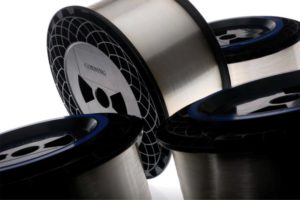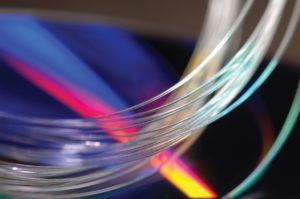Corning’s Roshene McCool explains how the SMF-28 Contour fiber reduces light losses, installation costs, and operating costs in fiber connections for 5G, computing, and datacenters.
Cellular transmitters and receivers are essentially digital-to-RF and RF-to-digital converters, depending on the direction of the signals. When not traveling over the air, demodulated baseband signals travel over fiber starting from the radio-access network (RAN). From there, optical signals travel to the network core and then to another user or to a datacenter. With demand for data ever increasing, telecom operators, datacenter operators, and private-network operators need to transport that data. In many instances, the physical infrastructure is running out of space for all those fibers.
At OFC 2021, fiber-optic cable pioneer Corning introduced SMF-28 Contour fiber. The company claims that this fiber can reduce optical signal losses, thus cutting costs in applications across networks. Corning claims that SMF-28 Contour fiber minimizes optical signal losses that occur in longer wavelengths and through tighter bends.
To learn about the SMF-28 Contour fiber and how its achieves the low loss, 5G Technology World spoke with Corning’s Roshene McCool, who specializes in single-mode fiber for access networks.
5GTW: Corning introduced a new optical fiber at OFC called SMS-28 Contour. What was SMF-28 designed for?
McCool: Networks are becoming more connected and congested. Fibers in the network need to support that ease of connection. We have more and more fiber in the networks. Unfortunately, the ducts are getting full. The available space to put that fiber into the network doesn’t change. We need to deal with our existing duct infrastructure.
In addition, worldwide pandemic has shown that we want increased reliability from our networks. We want low latency where response times will be machine led, not human led. That means we need lower latency, resiliency, and especially, we want fewer errors. Our SMF-28 Contour fiber was designed with a series of attributes that focus on these network challenges.
5GTW: What specific attributes?
McCool: The specific attributes of SMF-28 Contour fiber emphasize low loss, bend resiliency, and fiber size. The fiber is more bend resilient that its predecessors — it reduces errors from installations caused by bends. It also helps in operations because as the bandwidths of networks grow, we see usage in the optical C-band, about 1550 nm, the wavelength most impacted by bends in the fiber. The bend-resilient fibers reduce operational errors, not just installation errors.
Like all SMF-28 fibers, these Contour fibers have a 9.2 µm load-field diameter. It’s compatible with all SMF-28 fibers and with fibers deployed around the world.
Another attribute is fiber size. The SMF-25 Contour fiber comes in the usual 242 µm as well as a 188 µm diameter. It’s designed for high-density cables to get as much fiber into a given amount of space.
 5GTW: You mentioned that light in the C-band is particularly sensitive to bending. What makes the wavelength sensitive to bends as compared to longer or shorter wavelengths?
5GTW: You mentioned that light in the C-band is particularly sensitive to bending. What makes the wavelength sensitive to bends as compared to longer or shorter wavelengths?
McCool: It has to do with micro bends and macro bends. Micro bends occur when small perturbations along the fiber create loss. Macro bends occur when the fiber is bent beyond its minimum bend radius. Every fiber has a specified minimum bend radius. Bend affects longer wavelengths the most. Fibers are engineered so the light is contained within its mode-field diameter in the fiber’s center. That containment of the light within the fiber is compromised by a bend. The size of the bend where that occurs is described as the fiber’s minimum bend radius.
Because it’s about the containment of light in the fiber, the longer wavelength light escapes. You get more loss at longer wavelengths. The 1625 nm wavelengths have more loss than 1550 nm wavelengths and 1550 nm wavelengths have more loss than 1310 nm wavelengths. The longer wavelengths are where we see monitoring and transmission in modern networks.
The minimum bend radius is specified in a set of ITU requirements. Standard single-mode fiber is specified in the ITU-T G.657.A2 specification. The G.657 category of ITU recommendations specify a minimum bend resiliency of fibers. There are various recommendations within G.657. Our SMF-28 Ultra fiber exceeds the specification for minimum bend radius of 10 mm. SMF-28 Contour fiber is A2 minimum-bend radius of 7.5 mm. You can make tighter bends with the SMF-28 Contour fiber. The tighter the bend, the higher the loss. Longer wavelengths have more loss under bend.
5GTW: What are the applications for the SMF-28 Contour fiber?
McCool: The SMF-28 Contour fiber is designed for high-connectivity environments such as 5G and converged networks including fixed-line applications. That is, fiber to the home, fiber to the antenna, and fiber to the business.
 5GTW: At which points within the network might use SMF-28 Contour fiber?
5GTW: At which points within the network might use SMF-28 Contour fiber?
McCool: Our fiber fits everywhere. Fiber that’s resilient to bends is useful at the small cell and at the tower. As 5G lets us become an even more mobile society, it’s creating more need for fiber. You’ll find fiber going from the cell, through the network, to the datacenter and beyond — into the metro networks and in the long haul. Networks are becoming more fiber heavy even as we connect more devices through mobile radio.
5GTW: There’s a lot of talk about edge computing, moving the computing closer to the user to reduce latency. How might that change the amount or type of fiber compared to today’s more cloud-based computing?
McCool: We’ve yet to see edge computing become mainstream. The way it is described is essentially the proliferating of datacenters beyond the massive, hyperscale datacenter seen today in major cities. Edge computing could bring computing into smaller cities, maybe even bring computing into every small town. These smaller datacenters will need fiber.
5GTW: How does the SMF-28 Contour fiber change the design of the optical modules at each end of the fiber?
McCool: McCool: I’ll answer from an optical engineering perspective because that’s my background. The SMF-28 Contour fiber has lower loss and higher resiliency to bending than is required by the ITU G.652.D standard. There should be no difference in optical design to accommodate SMF-28 Contour fiber. The lower loss from bending should make designs easier. It can handle the bandwidths and wavelengths needed for telecom applications.
From a network perspective, engineers who design networks look at the practicalities of installing and maintaining them. This SMF-28 Contour fiber is designed to reduce installation and operational costs, letting engineers use networks more effectively.
5GTW: Are there any test and measurement issues that engineers need to know about working with the SMF-28 Contour fiber?
McCool: Measurements are the same as any single-mode fiber, in end to end, OTDR testing. We expect OTDR testing to be the same as with any fiber. Because of the lower-bend specifications compared to legacy fibers we expect to see lower losses, particularly at 1625 nm.







